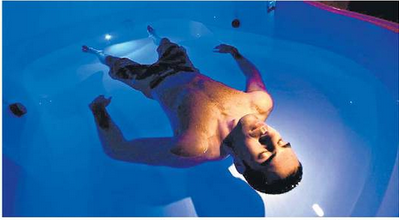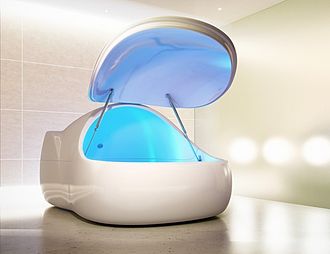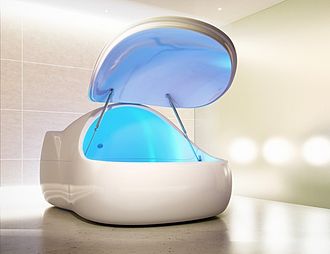Emily Noren takes a weekly 90 minutes swim in a dark chamber filled with Epsom salt water for de-stressing. The water has the same temperature as that of the body. She sees nothing and hears only her breath. To some people, this is a very scary method of de-stressing. But, Noren at 29 and some other people solve the stomach upset, and stress generated at work, and many troubles, by the way, narrated above.
Since many years in America, this technique of Float Therapy has emerged as an effective treatment for the mental and stress giving problems. Earlier this method was thought to be for drug addicts of LSD and got discarded.
The scientific community believes this method to be the shortcut to meditation. The people can achieve and attain deep satisfaction and peace without much effort. The director Dr. Martin Paulos MD, of Laureate Brain Research Institute (LIBR) says that the Float therapy is a good way to control the stress.
Floatation Therapy tank. Photo Source: Dainik Bhaskar
Now-a-days, Float Therapy is capturing the imagination and thinking of America. There were 85 Float centers in the US in 2011. On the popularization of the mental concept of concentration, today, these centers’ strength have gone up to 271. In Portland, in the state of Oregan, now an annual conference is held. Some of the health journals have published about a dozen research papers asserting that the Float Therapy is highly effective for treating the stress, strain and tension in healthy people. There is a definite treatment of Blood pressure, and the stress hormone cortisol reduce substantially. Still to confirm are the benefits in case of mental depression, sadness, and gloom through this therapy.
Researchers are working in this direction. In a report published in International Stress Management Journal, in a particular study, it is established that pain generated due to stress, discomfort and restlessness are treatable by the Float Therapy. They had a positive result of reducing the pain.
An Isolation Tank. Photo source: WIKIPEDIA
They will judge and evaluate the effect due to Float Therapy in people having Post Stress Traumatic Disorder. He feels that after floating therapy treatment, stress, discomfort and restlessness, the brain’s activities may reduce. They need more researchers to get ahead in the field. The belief that shutting out the material and external senses and giving the brain, the silence, would eventually control any stress, is the basis of a Therapy by BetterHelp.
All the five senses are isolated:
Skin: The air and water is at the same temperature of 34 degrees centigrade. Therefore, the body gets no feeling of touch.
Smell: By ultraviolet sterilization and chemicals keep the water free of any microbes and sediments, hence has no smell around.
Vision and Taste: Because of the density of the water being high, the mouth of the person floating has the face and the mouth above water. The vision is unaffected in pitch darkness, and the person does not get any water into the mouth. The brain does not get diverted or activated due to darkness.
Sound: Earplugs are used to keep all sounds away. During the floatation session the machines used, are switched off for any noise that they may produce. The focus remains on the body – i.e., hearing the heartbeat, the breath. It is easier to concentrate and meditate.
On 27th July 2015, Dr. Jaustin Feinstein is due to write in the Time on “Can Float Therapy really treat therapy?” He will share his knowledge on the features of float tanks and tell the way research will go on to find how relaxation techniques will help patients with psychiatric problems







